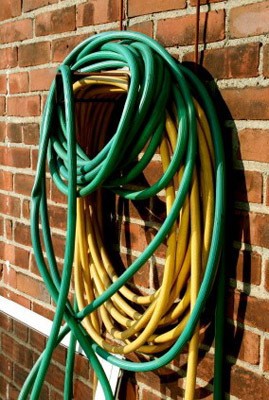
When it comes to watering garden plants, fancy irrigation systems are nice, but most of us still rely on Mother Nature, and a good old-fashioned garden hose to deliver the goods. Although it is one of the most easy-to-use tools in the shed, working with it can feel a bit like wrestling a wild beast, especially when taking it out and putting it away.
Let a Cart Do the Lifting
Even a short length of garden hose can be heavy to lift and awkward to carry. Depending on the size of your yard, dragging it to where you need it can put a lot of unnecessary strain on your back. Let your equipment take the weight off your back. Use wheeled carts and reels to make moving hoses around the garden easier.
Protect Tender Plants
Once uncoiled, use hose guides to keep hoses from and running over and crushing tender plants. Decorative guides can be purchased online or at garden centers, or you can save yourself some money by re-purposing found objects to make your own. Here are just a few ideas:
Hangers and Hooks
You'll get a longer life from your hose if you store it off the ground, and let the water drain out of it freely. One easy and inexpensive way to do this is to wind it around an old wheel rim attached to a fence post with the nozzle facing down.
Home improvement stores and garden centers offer a wide range of decorative metal hangers, which come ready to attach to your shed, garage, or house. Freestanding hose hangers are yet another option, albeit a pricey one. They take up more space, and unless anchored securely into the ground, they have a tendency to become wobbly over time.
Creative Coiling
Coiling your hose by hand can be an arduous task, and it's worth investing in equipment that makes the job as easy as possible - if only to spare you the frustration. Powered reels are nice because they wind your hose automatically. At the very least, a reel with a simple manual crank handle will enable you to wind your hose into a tidy coil.
An alternative to putting your hose away after each use, is to hide it away in freestanding container close to where you need it (e.g. a plastic garbage can cut in half, a large decorative terra cotta pot, or a half barrel).
A few simple hose attachments can help you save time and use water more efficiently.
Bubblers: Attached to the nozzle end of your hose, these devices turn a harsh stream of water into a gentle trickle. They are great for watering fragile seedlings and areas prone to erosion.
Quick-release Couplers: Screw them into faucets, hose ends, and attachments to connect your irrigation devices together quickly and easily.
Select Spray Nozzles: These nozzles are equipped with a dial that lets you choose between multiple types of spray settings. Depending on your watering needs, choose settings like mist, shower, stream, flat, jet, or even flood.
Water Wands: If you have to water hanging baskets or plants in the middle or near the back of a flower bed, attach a water wand to the nozzle end of your hose. Usually made from hard plastic or lightweight aluminum, they instantly extend your reach and allow you to direct water to hard to reach places.

About The Author: Ellen Brown is an environmental writer and photographer and the owner of Sustainable Media, an environmental media company that specializes in helping businesses and organizations promote eco-friendly products and services.
Add your voice! Click below to comment. ThriftyFun is powered by your wisdom!
Just an added idea in regards to using pieces of rebar as hose guides. I have a few in my backyard which work great however I was afraid of possibly tripping and falling on them. I found that an old piece of water hose cut just past the height of the piece of rebar works great.
Add your voice! Click below to comment. ThriftyFun is powered by your wisdom!